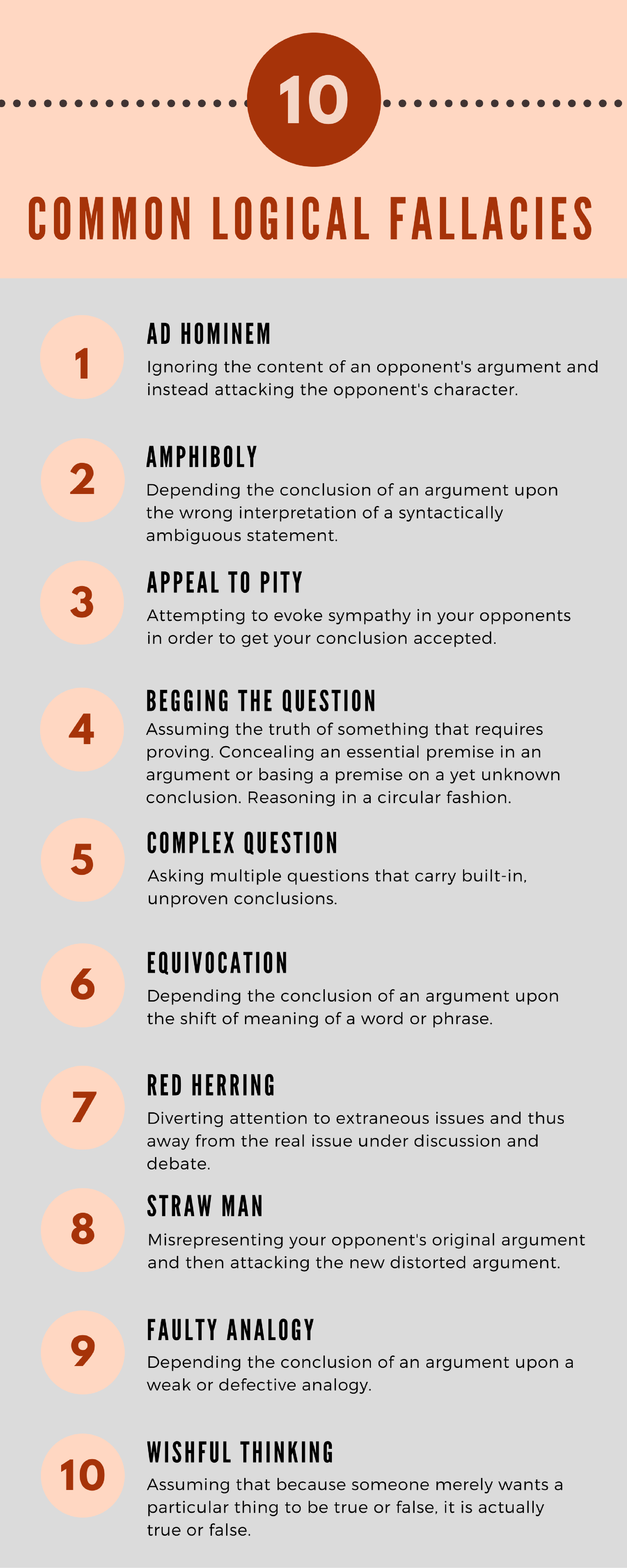By: Kenneth Samples | February 16, 2017
From: “reflectionsbyken.wordpress.com”
An essential skill to develop—particularly if you intend to discuss the truth of your faith with others—is how to understand, evaluate, and present a logical argument. Though it might seem complex and rather intimidating, an argument in logic is really a very simple thing. To have an argument you must make a claim (called the conclusion, or the central point of the argument) and provide support (called premises, or evidence, facts, and reasons) for believing the claim to be true or correct. To have a good argument (logically sound or cogent), your premises must be (1) true, (2) pertinent to your central claim, and (3) sufficient to justify the conclusion.
What Are Fallacies?
A fallacy occurs when a logical argument contains a specific defect. A defect is a mistake in the reasoning process which causes an argument to break down (or fail to adequately support the conclusion). Left unrecognized and uncorrected, that failure leads to a defeated (unsound or not cogent) argument. Bad arguments provide no logical justification for their claims. Thus the person who reasons carefully will attempt to understand and thus avoid committing the common fallacies that serve to shipwreck arguments.

E-R-A-S-E the Fallacies
Various fallacies (errors in reasoning) describe breakdowns in the all-important premise-conclusion relationship. As stated earlier, for the conclusion of an argument to be adequately supported, all premises must be true, and the argument must employ correct reasoning in using them. Here’s a logical checklist to follow that will help you avoid or erase the most common and dangerous fallacies.
1. Premises should solidly Establish the conclusion.
A viable argument provides support that genuinely establishes the argument’s central claim. Thus the careful thinker will be on guard to avoid unwarranted presumption. Good premises are not based on easily challenged assumptions, but instead on those rational elements that supply legitimate proof or evidence for accepting the conclusion. Common fallacies of presumption include Wishful Thinking, Begging the Question, and Complex Question. (See infographic.)
2. Premises should be Relevant to the conclusion.
The premises that do the supporting must be relevant, applicable, and/or pertinent to the conclusion. Thus the student of logic must be on the constant watch for logical irrelevancy. The support should be readily connected to the conclusion in terms of justifying, grounding, and counting in favor of the truth of the conclusion. Typical fallacies of relevance include Red Herring, Straw Man, Missing the Point, Ad Hominem, Appeal to Pity, and Appeal to Force. (See infographic.)
3. Premises should provide Adequate support for the conclusion.
The premises must sufficiently support the conclusion by providing enough evidence. Thus, the watchman on the logical wall must be aware that fallacies provide some support for the conclusion but ultimately not enough. The enough question should also involve queries about number, kind, and weight of support provided for the conclusion. Common fallacies of inadequacy (also called weak induction) include Appeal to Authority, Appeal to Ignorance, and Hasty Generalization.
4. Premises should provide Simple support for the conclusion.
Good premises avoid confusion and provide simple and clear support for the argument’s conclusion. Thus the logic enthusiast seeks to protect simplicity and clarity by eliminating vagueness (being blurry or fuzzy), ambiguity (having multiple meanings), and grammatical error. Thinking, speaking, and writing should reflect an inner logical unity and coherence. Common fallacies of ambiguity include Equivocation and Amphiboly. (See infographic.)
5. Premises that support the conclusion carefully weigh the Equivalence of comparisons.
Logical arguments often appeal to the use of causal connections and analogical relationships. Thus the reflective person will inquire as to whether these connections and relationships are truly equivalent. However, cause-and-effect connections can be difficult to track and analogies are sometimes difficult to weigh so logical mistakes can easily creep in. To be good at logic requires reflection upon categories and comparable relationships. The False Cause and Oversimplified Cause fallacies have premise-conclusion relationships that reflect problematic causal relationships. Whereas the Slippery Slope and False Analogy fallacies reflect breakdowns in comparing analogical relationships.
Logic is an indispensable tool for weighing and evaluating the merit of arguments, and knowing what constitutes a good argument greatly assists a person in discovering a rational and truthful vision of life. Following the logical checklist above can be of great use in attempting to avoid and ERASE those pesky and destructive logical fallacies…
Source: How to ERASE Logical Fallacies
 Kenneth Samples is the staff philosopher and apologist for Reasons to Believe (RTB). Visit RTB’s at http://www.reasons.org. Mr. Samples blogs at at “Reflections by Ken” at https://reflectionsbyken.wordpress.com. Mr. Samples has written several books including A World of Difference.
Kenneth Samples is the staff philosopher and apologist for Reasons to Believe (RTB). Visit RTB’s at http://www.reasons.org. Mr. Samples blogs at at “Reflections by Ken” at https://reflectionsbyken.wordpress.com. Mr. Samples has written several books including A World of Difference.





